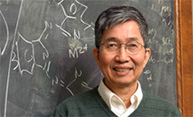The University of Rochester’s Ching Tang, a professor of chemical engineering at the Hajim School of Engineering and Applied Sciences, is being honored on two continents within the next week for his pioneering work on organic light-emitting diodes, or OLEDs, which are expected to become a dominant technology for flat screen displays.

The Eduard Rhein Foundation of Germany will present Tang with its technology award for “inventing the first highly efficient organic light emitting diode and further contributions to the development of organic semiconductor devices.” The award presentation will take place in the Hall of Fame of the Deutsche Museum in Munich tomorrow afternoon (Oct. 19).
“To see OLED technology being used in tens—perhaps hundreds—of millions of mobile phones all over the world is highly satisfying. And there is no doubt OLED TVs will set the standard for the next generation,” said Tang. “I am very pleased to have contributed to this transformation.”
According to the Rhein Foundation, Ching Tang is “an internationally renowned pioneer of organic electronics, who has created the foundation for revolutionary new types of displays and illuminations.”
Tang, along with Steven Van Slyke, invented the organic light-emitting diode (OLED), which gave birth to a multi-billion-dollar industry. The diodes have been used to create displays in cell phones, computers, and televisions that are much more energy efficient, thinner, and offer a more realistic picture than LCD displays. When he published his seminal paper on the technology in 1987 in the journal Applied Physics Letters, Tang was employed by the Eastman Kodak Company. To this day, that paper has been cited by more scientists than any other paper in the history of the well-regarded journal.
The Eduard Rhein Foundation was formed in 1976 to promote scientific research, learning, arts, and culture.
A second honor for Tang comes on Tuesday (Oct. 22), when he and Van Slyke will be inducted into the Consumer Electronics (CE) Hall of Fame. The Consumer Electronics Association credits Tang and Van Slyke for their “pioneering work” that led to OLED displays.
The CE Hall of Fame, created in 2000, honors visionaries in the consumer technology industry who advance innovation and build a strong foundation for others to follow.
OLEDs are made of very thin—about 200 times thinner than a human hair—layers of organic molecules. A power source is used to send a current to an outer layer, where electrons are absorbed by atoms, giving off photons of light. The color of the light depends on the type of organic molecules in the layer, while the brightness of the light is related to the intensity of the current.
Earlier this year, Tang accepted an additional appointment at the Institute of Advanced Study, Hong Kong University of Science and Technology.





